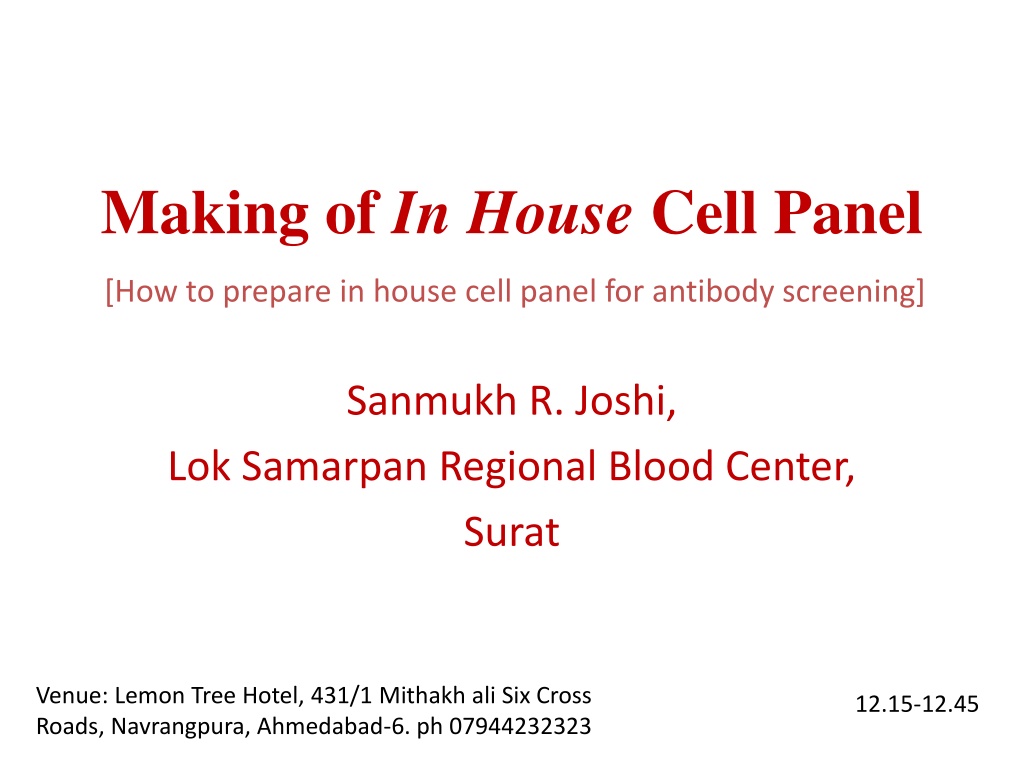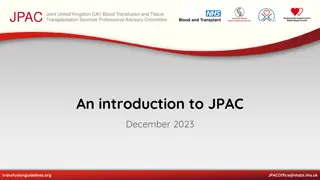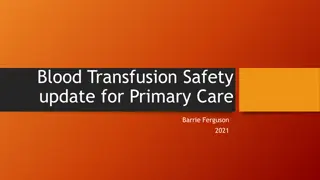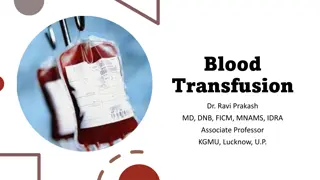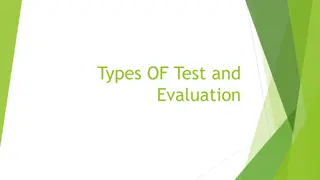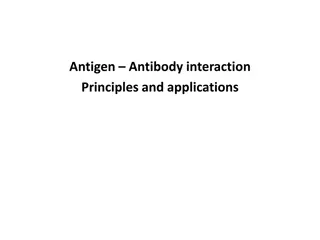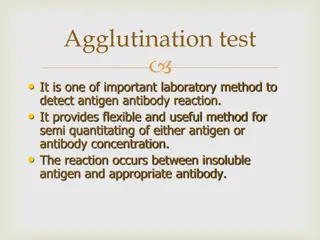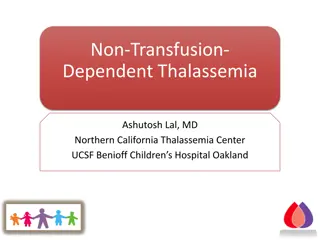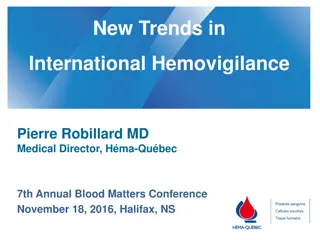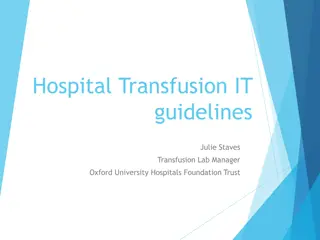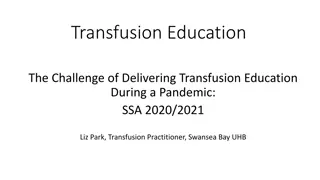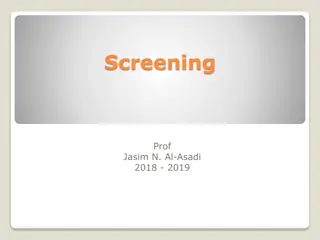Understanding Antibody Screening and Pre-Transfusion Tests
In-house cell panel development, pre-transfusion compatibility testing, antibody screening methods, and the importance of ABO and Rh typing are discussed in detail. Steps for safe blood transfusion, reverse ABO grouping, AST testing for irregular antibodies, and selection criteria for screen cells in antibody screening are highlighted.
Download Presentation

Please find below an Image/Link to download the presentation.
The content on the website is provided AS IS for your information and personal use only. It may not be sold, licensed, or shared on other websites without obtaining consent from the author. Download presentation by click this link. If you encounter any issues during the download, it is possible that the publisher has removed the file from their server.
E N D
Presentation Transcript
Making of In House Cell Panel [How to prepare in house cell panel for antibody screening] Sanmukh R. Joshi, Lok Samarpan Regional Blood Center, Surat Venue: Lemon Tree Hotel, 431/1 Mithakh ali Six Cross Roads, Navrangpura, Ahmedabad-6. ph 07944232323 12.15-12.45
In house Cell Panel Consider the attempts as developmental steps in our set up Not a classical roadway, but a wild path adopted to get what we needed the minimum Routing blood bank serology- sample to bench work: the Pre- transfusion tests. Importance of ABO and Rh typing. Why not other blood groups (OBG)? What do we do to cover obg? AST. a use of pooled O cells, advantage and limitation role of AST cells and cell panel construction of cell panel (reverse grouping, Ab screen & identification)
Pre-Transfusion Compatibility Tests Pre-transfusion steps: 1. Identity of the patient and the donor. 2. Review of the past transfusion records of patient. 3. Performing ABO and Rh.D grouping. 4. Screening for unexpected antibody. 5. Cross-matching between the patient and the donor. 6. Re-identification of patient/ blood before transfusion. For a safe blood transfusion all the 6 steps needs to be addressed. Steps 3-5 are referred to as the compatibility test. Sept12
Antibody Screening In reverse ABO grouping Detecting expected/regular/ typical antibodies to A and B antigens; helps confirming the forward grouping In house, we use pooled A and B red cells 3 donors each of group A and B are washed separately in saline, then pooled group-wise to make 5% suspension Commercial cells supply has a single donor of A1 and B cells; both being Rh.D neg to avoid interference of anti-D, if present. Also, supply A2 cells to identify anti-A1 if detected. The cells are re-suspended in diluents having EDTA to prevent haemolysis in reverse grouping, if serum is fresh.
Antibody Screening Test (AST) ABO and Rh grouping is performed as routine pre- transfusion test to select homologous blood for transfusion. Red cell typing for other blood groups (OBG) is not routinely done, so homologous blood for OBG is not selected for transfusion. Antibodies to antigens of the OBG are not regularly occurring yet some may prove clinically significant. AST is aimed to detect such irregular/ atypical/ unexpected antibodies to OBG 0.3-2 % of the people have a presence of irregular antibody to antigens of the OBGs
Antibody Screen Cells A use of selected screen cells is meaningful and an ideal approach in antibody screening for irregular antibodies. Selection criteria include: Group O: because naturally occurring anti-A or anti-B should not interfere with detection of unexpected antibodies. To cover the RBC phenotype for most common antigens, e.g. D, C, E, c, e, M, N, S, s, P1, Lea, Le b, K, k, Fya , Fy b, Jka, Jk b. Have homozygous expression of certain antigens helps detecting weakly reacting antibodies showing dosage- effect Have a set of at least 2 donors RBC samples If one of the sets lacks any of the antigens, the other one must have it.
Commercial screen cells Available under different names, e.g. Selectogen I and Selectogen II Antigram listing the antigen make up of each RBC sample provided with lot (batch) number by the manufacturer the lot number on the screen cells sample must matches with that on the antigram Limitations: Rare antigens (f <1%, like Lua, Kpa, Ina) are not included in the screen cells, antibodies to those are not detected by routine AST. Antibody may be missed in AST if its concentration drops below detectable limit. Particularly antibody showing dosage effect, with heterozygous
Antibody Screen Cells In house, we use gr O pooled red cells to detect irregular antibodies and is in practice for a long time. Red cells from 3 gr O donors are washed separately and pooled to make a 5% suspension of each. Presumed to cover the most common antigens of different blood groups in this random cells pool. It is a blind approach Homozygous antigen profile may not be ensured A weak antibody that show a dosage effect may be missed
Commercial screen cell Panel. Two or three cell-suspensions from individual donors for antibody detection in the patients, or One cell suspension, pooled from 2 or more donors for the antibody screening in donors Why this discrimination from the patients and the donors is a question unsolved for me!
Antibody Identification (AbID) Test Once detected, the antibody need to be identified To determine antibody specificity (name) To determine clinical significance To ascertain if antibody could cause HTR Help selecting appropriate antigen-neg blood for transfusion Important for investigation for monitoring the episode of HTR/ HDN/AIHA
Antibody Identification: use of Commercial cell Panel Commercially available kit with red cell suspensions of 11 group O donors, in ready-to-use fashion. Accompany the antigram with lot number showing the antigen make up of each RBC sample It is important to match the lot (batch) number shown in antigram with the lot number on the cell panel. Three sets of panel designated as A, B and C for their specific use.
Commercial cell Panel Panel A: A primary panel that provides homozygosity of major blood group antigens, Allows identification through differential reactivity of frequently encountered single/ multiple antibody combinations. Panel B: For use in complement with Panel A to identify more difficult antibody combinations. Panel C: In two sets - one untreated and another enzyme-treated
Commercial cell Panel. Panel C . to identify weakly reacting antibodies and To separate mixtures of antibodies, if one is reacting with untreated cells and the other is directed against enzyme-sensitive antigens. Enzyme-treated red cells assist in the identification of antibodies in 2 ways: enhance reactivity of some Ag/Ab reaction e.g. the Rh or Kidd blood group systems destroy the antigens of the MNS, Duffy, IN systems
Commercial cell Panel. Limitations As the supply originates from the West, so is expensive Expiry dates as per the manufacturing date at the source by the time it arrives at our place, enough days are lapsed so the effective days for the end user is limited to only few weeks. An expensive material is of no use once expired (~FDA). Antigens profile as per occurrence in Western population Our region/ country specific antigens may be missed There is a clear need to have our own cell panel for detection/ identification of antibodies in our set up.
In house cell panel: our First attempt Cell typing on staff members/ students at BGRC, Mumbai and its surrounding institutions like KEM Hosp, Wadia Mat Hosp, Tata Mem Hosp, Cancer Res Inst., Haffkine Inst. Using antisera available as locally identified sources/ gift Only limited antigens were typed, many of which ware clinically non-significant like M, N, Lewis, P1 etc. We had enrolled good number of people in our panel for all ABO groups but, group O being the most useful one. Sometimes we used to face problem of mistaken identity of the donor particularly if we entrusted others to get the sample An interesting event of Mr. Vin and anti-Vin that turned out to be resolved as anti-B after extensive efforts put up for two days!!!
First attempt in BGRC No samples were frozen-preserved, collected afresh as often as required in normal saline, by finger prick. Antibody specimens were stored until enough case were accumulated to make optimal use of cells collected Besides reactivity with cell panel, antibody identification was guided by nature of antibody as sensitivity to temperature, enzyme, hemagglutination inhibition by soluble antigens in saliva (Lewis, H, etc), milk (I), hydatid cyst fluid (P1). Sometimes, we used to get a supply of rare red cells from International group called SCARF
In house cell panel: UK experience I had developed a good taste on cell panel used during my work-visit to a regional blood center in the UK. They had in house cell panel of enormous magnitude. So many fully typed red cells were available in store to make the daily panel and the days panel Daily panel being constant, the days panel varied from Monday through Sunday. With an antibody requiring exhaustive work up, one can test with almost 90 different red cells at any given time! I tested one serum with these cells that was to be anti-Inb ...and there I started dreaming on making our own panel
An aborted attempt Meanwhile, I moved from place to place - city to city in different countries to earn my daily living ! Once with Indian Red Cross Blood Centre, Mumbai, I was prompted to prepare a budget-proposal for in house cell panel. I was very happy over the suggestion. I thought to keep a bare minimum cost to get it through. Only expenses for antisera amounted to ~Rs 90,000/- The proposal was submitted just to know after a long wait that it was not to be approved for it was toosmallto get! Then on, I thought of relying on commercial supply- albeit based on free gift, no matter it is of an out-dated kind!
In house cell panel: Current Set up Choose group O+ and O- regular donors First, to test for rare antigens. Antisera to be used in utmost conservative manner saving close to be exercised After reading the results, the test supernatant was aspirated for reuse in further screening in parallel to a pos control 3/70 random gr O red cells tested with anti-E 2/67 Tibetans samples tested with anti-Dia 5/212 O, Rh neg cells were tested with anti-Ina Besides, random donors at LSRK were screened for antigens Dia, Mia, Mur and all of them lacked these rare antigens.
Our experience Then we tested a few random red cells for the common antigens with appropriate antisera a few obtained from commercial sources and others through the Gift. Looked for homozygosity for certain antigens that usually show the dosage effect, e.g. Jk, MNSs, C, E, Fy etc. The following chart shows antigram on the in house cell panel we made.
Coombs Control Cells Sensitized with lgG ant-D to check false neg AHG results. Difficult to procure anti-D for preparation of the red cells. In face of saline reacting monoclonal anti-D, no paid donors are immunized now a days In an advent of RhIg being used to prevent the Rh- sensitization, no natural IgG anti-D is available I have developed an unique strategy: In Rh-HDN treatment of exchange transfusion, ask the doctor to collect the baby s first two blood aspirates and send us The baby s plasma + ether-eluate prepared from the baby s red cells are pooled and used as a source for anti-D. The anti-D augmented gives beautiful sensitized red cells!
In house cell panel: storage in frozen We preserve these cells in frozen state (in glycerol citrate). In 40% Glycerol-citrate solution taking 60 parts 3.8% tri-sodium citrate solution + 40 parts glycerol; Shake well to mix the content Packed red cells and the glycerol citrate solution were mixed in equal quantity and kept under roller-mixer device (VDRL-Shaker is good enough) for one hour. Distribute the glycerolized red cells in smaller aliquots and store at -25 C
In house cell panel: Reconstitution for use Reconstitute the cells by washing them in solutions of gradually reduced glycerol content. Prepared serial dilutions of 40% Glycerol in 3.8% citrate Mixed the thawed red cells in Tube 1, centrifuged, decant ed the supernatant and added/ mixed the next dilution and like-wise washed the red cells till the 5th tube. Give one more wash with normal saline. Tube 1 Tube 2 Tube 3 Tube 4 Tube 5 citrate citrate citrate Citrate + saline saline 40% Glycerol 20% Glycerol 1 0% Glycerol 5% Glycerol 2.5% Glycerol 20% Glycerol 1 0% Glycerol 5% Glycerol 2.5% Glycerol 1.25% Glycerol
In house cell panel: Liquid storage solution Once reconstituted, the red cells are suspended as 5% in the following preservative solution to store and use for 2 months Formula: Trisodium Citrate Dihydrate Sodium Chloride Dextrose Inosine Adenosine Triphosphate (ATP) Chloramphenicol Neomycin Sulphate Water 8 g/L 4.2 g/L 20.5 g/L 0.4 g/L 0.4 g/L 0.4 g/L 0.1 g/L
Acknowledgement Hungary Blood Transf Center, Budapest for anti-K, -Dia Japanese Red Cross Blood Center for anti-Dia, -Mia, -Mur New York Blood Center, for anti-Fya, Fyb -S,-k, -Jka, Jkb, -Dib Ortho Clinical Diagnostics for anti-s
